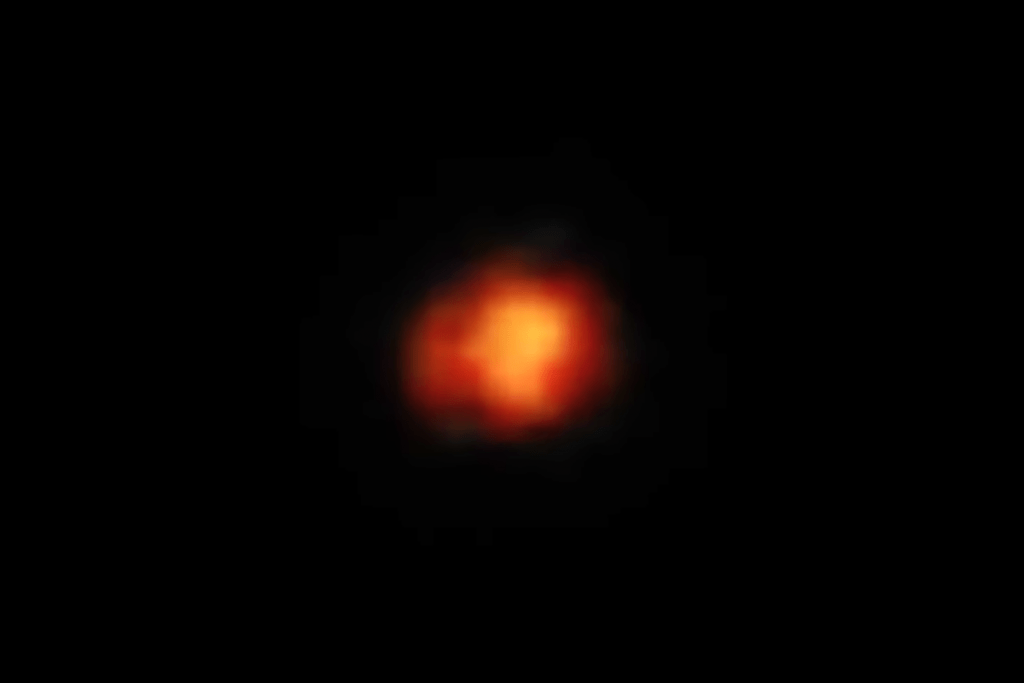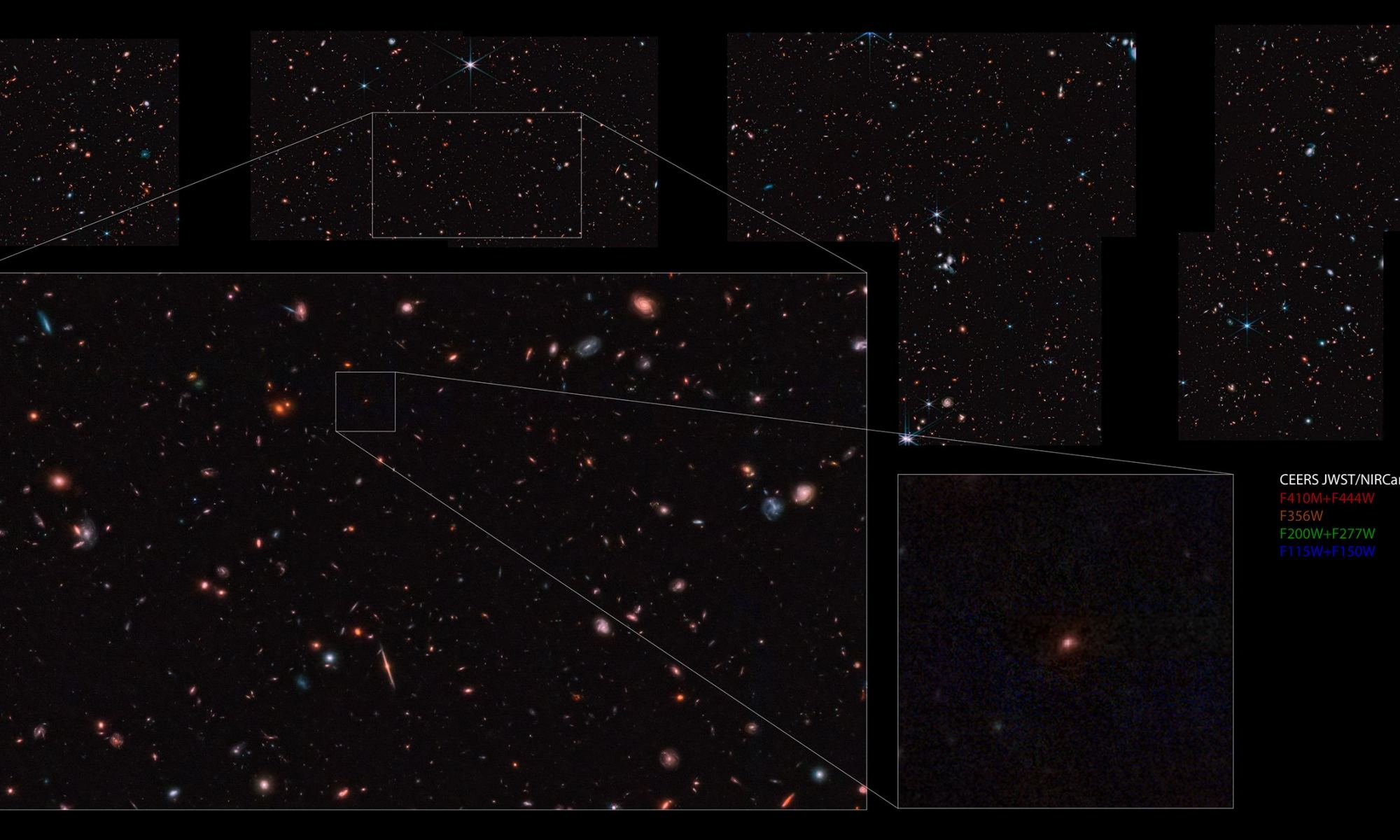One of the main objectives of the James Webb Space Telescope (JWST) is to use its powerful optics and advanced instruments to observe the earliest galaxies in the Universe. These galaxies formed about 1 billion years after the Big Bang, coinciding with the end of what is known as the “Cosmic Dark Ages.” This epoch is inaccessible for conventional optical telescopes because the only sources of photons were largely associated with the relic radiation of the Big Bang – visible today as the Cosmic Microwave Background (CMB) – or were the result of the reionization of neutral hydrogen (visible today the 21 cm line).
Thanks to its advanced optics and infrared imaging capabilities, Webb has pushed the boundaries of how far astronomers and cosmologists can see. One of the most interesting finds was Maisie’s galaxy, which appeared to have existed roughly 390 million years after the Big Bang. According to a new study by the Cosmic Evolution Early Release Science Survey (CEERS) that recently appeared in Nature, these results have since been confirmed. This makes Maisie’s galaxy one of the farthest (and earliest) confirmed galaxies ever observed by human eyes.
The team was composed of astronomers and astrophysicists from the NSF National Optical-Infrared Astronomy Research Laboratory (NOIRLab), the University of Texas at Austin, the Laboratory for Multiwavelength Astrophysics (RIT-LMA), the Royal Observatory’s Institute for Astronomy, the Centre National de la Recherche Scientifique (CNRS), Instituto de Investigación Multidisciplinar en Ciencia y Tecnología, the Cosmic Dawn Center (DAWN), the Niels Bohr Institute, the Space Telescope Science Institute (STScI), the National Astronomical Observatory of Japan (NAOJ), the NASA Goddard Astrophysics Science Division, and multiple universities and institutes.
By observing the earliest stars and galaxies, astronomers hope to unlock some of the most profound secrets of cosmic evolution. This includes how the earliest stars seeded the galaxy with heavy elements, when and where the first supermassive black holes (SMBHs) formed, and how the cosmic structure has since evolved. The answers these observations will reveal will help scientists address other profound questions regarding the formation of planet systems and the building blocks of life.
Maisie’s galaxy first became apparent to astronomers using the JWST last summer. At the time, observations placed this galaxy at an apparent distance of about 13.5 billion light-years. For many years, the record for the farthest galaxy was held by Gz-11, observed by the venerable Hubble Space Telescope in 2016. In 2020, observations by the NOIRLab and the Cosmic DAWN center pushed the limit further with their observations of EGS77, a galaxy that existed when the Universe was just 680 million years old.
By 2021, the record was broken again by researchers led by the Kavli Institute for Astronomy and Astrophysics, which identified GN-z11 – which existed when the Universe was roughly 400 million years old. Last summer, the CEERS collaboration believed they spotted an earlier candidate with the discovery of Maisie’s galaxy. This campaign was led by Steven Finkelstein, a professor of astronomy at the University of Texas at Austin, the principal investigator for the Cosmic Evolution Early Release Science Survey (CEERS), and a co-author of this latest paper. Finkelstein named the galaxy after his daughter, as it was discovered on her birthday.
Based on their analysis, they estimated that the galaxy formed just 250 million years after the Big Bang. The latest analysis, led by NOIRLab postdoctoral research associate Pablo Arrabal Haro, confirms that Maisie’s galaxy existed when the Universe was 390 million years old. While not as young as the CEERS team initially thought, Maisie’s galaxy is still one of the four earliest confirmed galaxies. “The exciting thing about Maisie’s galaxy is that it was one of the first distant galaxies identified by JWST, and of that set, it’s the first to actually be spectroscopically confirmed,” he said in a UT News release.

The original estimates of redshifts were based on photometry measurement of data collected by CEERS during its allotted time for Webb‘s Cycle 1 General Observers (GO) programs. To get a more accurate estimate, the CEERS team conducted follow-up measurements with the JWST Near-infrared Spectrometer (NIRSpec). According to their analysis of its spectra, Maisie’s galaxy has a redshift value of z=11.4. For this latest study, the collaboration also looked at CEERS-93316, a galaxy originally found in 2022 as part of a CEERS study led by astronomers from the University of Edinburgh.
At the time, the team estimated that the galaxy had a record-setting redshift of z = 16.7, indicating that it formed just 250 million years after the Big Bang. Upon further analysis, they found that their results were confounded by the presence of hot gas in the galaxy, which made it appear much bluer than it actually was – and much brighter than our models predict for early galaxies. The blue tint mimicked the signature the CEERS team expected to see in very early galaxies, which were populated by particularly massive and intensely bright blue stars.
Their latest analysis determined that CEERS-93316 has a more modest redshift of z=4.9, corresponding to an age of about 1 billion years after the Big Bang. Said Finkelstein:
“This was a kind of weird case. Of the many tens of high redshift candidates that have been observed spectroscopically, this is the only instance of the true redshift being much less than our initial guess. It would have been really challenging to explain how the universe could create such a massive galaxy so soon. So, I think this was probably always the most likely outcome, because it was so extreme, so bright, at such an apparent high redshift.”
The CEERS team’s paper, “Confirmation and refutation of very luminous galaxies in the early universe,” appeared in Nature on August 14th, 2023. The CEERS team is currently evaluating several other galaxies that might predate Maisie’s galaxy, pushing the study of the early Universe even further.

